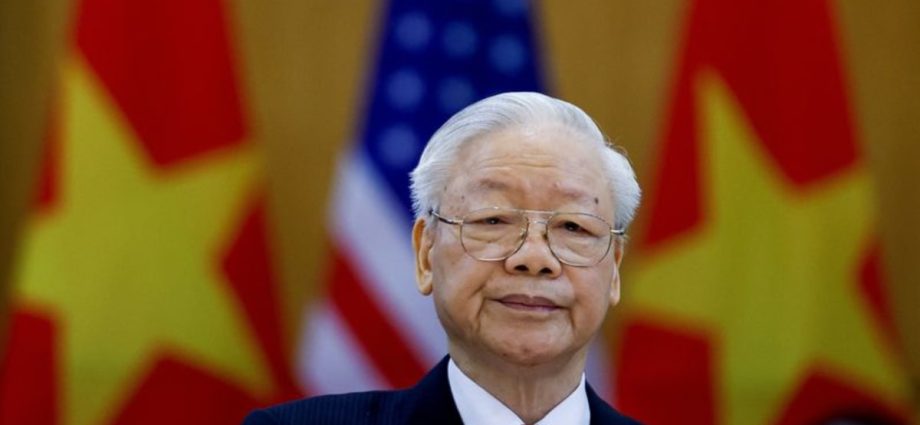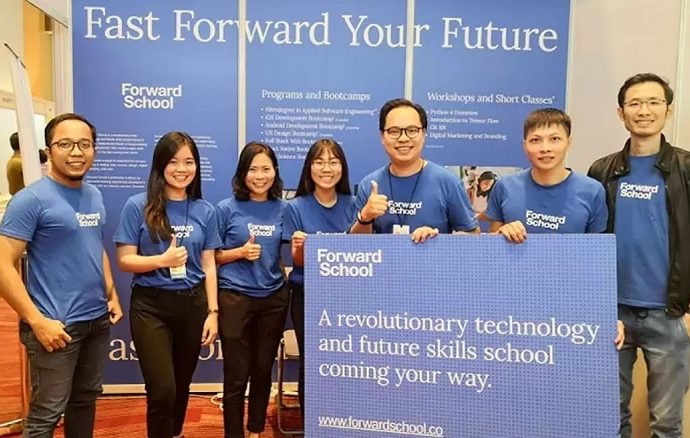Vietnam’s top leader misses meetings amid health concerns
The head of Vietnam’s Communist Party Nguyen Phu Trong is expected to miss on Friday (Jan 12) the second state visit of a foreign leader to Hanoi in less than a week amid concerns about his health. Trong, 79, who has been at the helm of the party since 2011,Continue Reading
Germany’s Scholz slams ‘fanatics’ after far-right deportation row
BERLIN: German Chancellor Olaf Scholz urged democrats to stand against far-right “fanatics” after reports emerged of Alternative for Germany party members attending a meeting where expelling citizens with foreign ethnic backgrounds was discussed. The AfD did not deny that two of its senior politicians attended the November meeting in aContinue Reading
Former ministers face bribery charges over labour exports
DSI says total of B36 million paid out to secure work in Finland for Thai berry pickers
PUBLISHED : 11 Jan 2024 at 18:14
UPDATED : 11 Jan 2024 at 18:35

The Department of Special Investigation (DSI) says it will file charges against two former ministers and two high-level officials at the Ministry of Labour for allegedly demanding 36 million baht in exchange for approving the export of Thai workers to Finland.
The DSI said on Thursday that it has evidence to back the bribery allegations against the four individuals, with some of the evidence coming from authorities in Finland.
The statement did not name the politicians or officials.
According to the DSI, a group of politicians, civil servants and civilians demanded that a Thai job broker pay an average of 3,000 baht for each worker destined to work harvesting wild berries in the Scandinavian country.
The broker in turn passed the special requirement on to about 12,000 Thai workers exported from 2020 to 2023. They had to pay altogether about 36 million baht in addition to other expenses.
The DSI said that both it and public prosecutors had agreed to press the charges with the National Anti-Corruption Commission (NACC).
From 2020 to 2023 the labour minister was Suchart Chomklin, now a list MP and deputy leader of United Thai Nation, one of the parties in the governing coalition.
The veteran Chon Buri politician said on Thursday that he was innocent and would defend himself in the justice system.
“I did nothing wrong and I have no worries,” he said. “I have never been summoned for questioning and neither have any government officials.”

Suchart Chomklin, who served as labour minister from 2020-23, chats with Thai workers during a visit to a berry picking site in Finland in 2022. He has denied any involvement in the bribery alleged by the DSI. (Photo: Ministry of Labour)
Bukit Merah hawkers say business worse than during COVID-19 pandemic after reports of tuberculosis cases

“VERY BAD” BUSINESS
Mr Yong, a hawker who sells soup at ABC Brickworks, closed his stall due to the drop in business.
The 69-year-old, who declined to give his full name, had gone for his mandatory screening on Thursday but decided to head home after.
“When the newspaper announced the screening, there was a 50 per cent drop in business,” he said in Mandarin.
“Since there is such a drop in business, I might as well take a break and don’t waste my time. If you cannot earn money you might as well rest. The ingredients I use to make my soup are not cheap,” he said.
Another hawker whose stall sells satay and chicken wings described the situation as “very, very bad”.
“Not only me, every store (is bad). I think it will be like this for a few weeks. Hopefully it will be better soon,” said Mr Lim, who also cited having 50 per cent fewer customers than before.
Personally, Mr Lim is not worried about his health as he has read about how tuberculosis is spread.
According to MOH, transmission of the tuberculosis bacteria from active cases usually requires prolonged exposure – days to weeks of exposure rather than minutes to hours. It also said a person cannot get tuberculosis from sharing cups, utensils or food.
Tuberculosis is also not spread through shaking hands, kissing or touching bed linens or toilet seats.
Referring to this information, a regular patron who gave his name as Mr Loh, said: “Life has to go on. You just have to take precautions.”
Mr Loh, who was seen seated at the food centre, said he was in the area about four to five times a week to visit a relative.
The 54-year-old, who works in the technology industry, intends to go for voluntary screening but notes that the disease is not as serious as COVID-19.
“COVID is more serious, because it’s more infections and it spreads very fast and the impact can be felt within days. So this one probably we just have to be more cautious, so wear masks when necessary.”
Expressing the same sentiments, Mr Chua told the media: “TB is quite unlike COVID. It does not spread as easily.”
“There’s plenty of good hawker food here at this market,” he added.
“And I’m sure that we will all like to continue supporting our favourite hawkers so that their livelihoods are not too adversely impacted.”
Highly transmissible but mild Covid strain now dominant
Virologist expects JN.1 cases to soar for a few weeks before dropping again
PUBLISHED : 11 Jan 2024 at 18:01

The JN.1 strain of Covid-19, which is highly transmissible but with mild symptoms, is now dominant in the country, says the well-known virologist Yong Poovorawan.
The strain was first detected in the United States and is expected to replace all other strains of Covid-19 because it spreads so easily, he wrote on Facebook on Thursday.
“Those infected with the JN.1 strain will not have severe symptoms. Some people only have a cold and sore throat, like ordinary respiratory illnesses,” said Prof Yong, head of the Centre of Excellence in Clinical Virology at Chulalongkorn University.
“It is highly transmissible and repeated infection is possible. So, cases will soar, especially after New Year. Their number will start to drop in February and plunge in March.”
Later infections will subside until the next spread season starts in June, he wrote.
Dr Thongchai Keeratihattayakorn, director-general of the Department of Disease Control, said Covid-19 still needs to be monitored closely because it mutates continuously.
Although most people have immunity and their symptoms are mild, vulnerable people should take precautions, especially elderly people, pregnant women and those with hypertension, chronic kidney failure, obesity and cancer, he warned.
Last year there were 652,868 Covid-19 cases, with 848 deaths linked to the disease. Dr Thongchai expects there will be 649,520 Covid-19 cases this year.
Penang’s startup ecosystem receives recognition with Georgetown as 8th ranked city in Southeast AsiaÂ
Georgetown is 2nd highest-ranked city in Malaysia with KL at 4th spot
Supporting startup ecosystem part of plan to attract high-tech industries
In a statement, Digital Penang marked a significant milestone for Penang’s technology startup ecosystem as it received the “Outstanding Ecosystem among Medium-Sized Population Cities in Southeast Asia 2023” award from StartupBlink, a leading startup…Continue Reading
CNA Explains: Why some Singapore commuters are upset about transitioning to SimplyGo

SINGAPORE: The Land Transport Authority’s (LTA) announcement that bus and train payment cards must be upgraded has roused online discussions about whether such a move was necessary.
What’s going to change, and why?
From Jun 1, adult EZ-Link cards and NETS FlashPay cards can no longer be used on buses and trains, LTA announced on Tuesday (Jan 9).
Commuters who are using these payment methods will have to upgrade their cards to SimplyGo EZ-Link cards or exchange them for NETS Prepaid Cards.
Concession card users will not be affected. Those who are using contactless bank cards and mobile wallets on phones or smartwatches are already on the SimplyGo platform, which was introduced in 2019, and also will not be affected.
Around two-thirds of adult public transport fares are currently paid through SimplyGo EZ-Link cards or bank cards.
“With the growing adoption of SimplyGo payment methods, and the legacy card-based ticketing system for adult commuters nearing the end of its operational lifespan, we are therefore transitioning all adult commuters to the SimplyGo platform,” said LTA.
The authority also highlighted the benefits of SimplyGo, such as topping up multiple EZ-Link cards using its mobile app; blocking transactions if a card is misplaced; and receiving notifications on fares and card balances.
Last March, the LTA announced that the EZ-Link and TransitLink SimplyGo mobile apps would be merged into a single platform. At the time, the authority said there would be no change to how commuters paid their fares. There was also no indication that older EZ-Link cards would be phased out.
China coast guard enters disputed waters in the East China Sea
BEIJING/TOKYO: The Chinese coast guard said it patrolled the territorial waters of the Diaoyu Islands on Thursday (Jan 11) to conduct “right protection” cruises. The East China Sea islets are claimed by both China and Japan, which calls them the Senkaku Islands, and have long been a sticking point inContinue Reading
NY Times vs OpenAI could short-circuit the chatbot revolution
In 1954, the Guardian’s science correspondent reported on “electronic brains”, which had a form of memory that could let them retrieve information, like airline seat allocations, in a matter of seconds.
Nowadays the idea of computers storing information is so commonplace that we don’t even think about what words like “memory” really mean. Back in the 1950s, however, this language was new to most people, and the idea of an “electronic brain” was heavy with possibility.
In 2024, your microwave has more computing power than anything that was called a brain in the 1950s, but the world of artificial intelligence is posing fresh challenges for language – and lawyers.
Last month, the New York Times newspaper filed a lawsuit against OpenAI and Microsoft, the owners of popular AI-based text-generation tool ChatGPT, over their alleged use of the Times’ articles in the data they use to train (improve) and test their systems.
They claim that OpenAI has infringed copyright by using their journalism as part of the process of creating ChatGPT. In doing so, the lawsuit claims, they have created a competing product that threatens their business.
OpenAI’s response so far has been very cautious, but a key tenet outlined in a statement released by the company is that their use of online data falls under the principle known as “fair use.” This is because, OpenAI argues, they transform the work into something new in the process – the text generated by ChatGPT.
At the crux of this issue is the question of data use. What data do companies like OpenAI have a right to use, and what do concepts like “transform” really mean in these contexts? Questions like this, surrounding the data we train AI systems, or models, like ChatGPT on, remain a fierce academic battleground. The law often lags behind the behavior of industry.
If you’ve used AI to answer emails or summarise work for you, you might see ChatGPT as an end justifying the means. However, it perhaps should worry us if the only way to achieve that is by exempting specific corporate entities from laws that apply to everyone else.
Not only could that change the nature of debate around copyright lawsuits like this one, but it has the potential to change the way societies structure their legal system.
Fundamental questions
Cases like this can throw up thorny questions about the future of legal systems, but they can also question the future of AI models themselves. The New York Times believes that ChatGPT threatens the long-term existence of the newspaper.
On this point, OpenAI says in its statement that it is collaborating with news organizations to provide novel opportunities in journalism. It says the company’s goals are to “support a healthy news ecosystem” and to “be a good partner.”
Even if we believe that AI systems are a necessary part of the future for our society, it seems like a bad idea to destroy the sources of data that they were originally trained on. This is a concern shared by creative endeavors like the New York Times, authors like George R R Martin, and also the online encyclopedia Wikipedia.
Advocates of large-scale data collection – like that used to power Large Language Models (LLMs), the technology underlying AI chatbots such as ChatGPT – argue that AI systems “transform” the data they train on by “learning” from their datasets and then creating something new.

Effectively, what they mean is that researchers provide data written by people and ask these systems to guess the next words in the sentence, as they would when dealing with a real question from a user.
By hiding and then revealing these answers, researchers can provide a binary “yes” or “no” answer that helps push AI systems towards accurate predictions. It’s for this reason that LLMs need vast reams of written texts.
If we were to copy the articles from the New York Times website and charge people for access, most people would agree this would be “systematic theft on a mass scale” (as the newspaper’s lawsuit puts it). But improving the accuracy of an AI by using data to guide it, as shown above, is more complicated than this.
Firms like OpenAI do not store their training data and so argue that the articles from the New York Times fed into the dataset are not actually being reused. A counter-argument to this defense of AI, though, is that there is evidence that systems such as ChatGPT can “leak” verbatim excerpts from their training data. OpenAI says this is a “rare bug.”
However, it suggests that these systems do store and memorize some of the data they are trained on – unintentionally – and can regurgitate it verbatim when prompted in specific ways. This would bypass any paywalls a for-profit publication may put in place to protect its intellectual property.
Language use
But what is likely to have a longer-term impact on the way we approach legislation in cases such as these is our use of language. Most AI researchers will tell you that the word “learning” is a very weighty and inaccurate word to use to describe what AI is actually doing.
The question must be asked whether the law in its current form is sufficient to protect and support people as society experiences a massive shift into the AI age. Whether something builds on an existing copyrighted piece of work in a manner different from the original is referred to as “transformative use” and is a defense used by OpenAI.
However, these laws were designed to encourage people to remix, recombine and experiment with work already released into the outside world. The same laws were not really designed to protect multi-billion-dollar technology products that work at a speed and scale many orders of magnitude greater than any human writer could aspire to.
The problem with many of the defenses of large-scale data collection and usage is that they rely on strange uses of the English language. We say that AI “learns”, that it “understands”, that it can “think.” However, these are analogies, not precise technical language.
Just like in 1954, when people looked at the modern equivalent of a broken calculator and called it a “brain”, we’re using old language to grapple with completely new concepts. No matter what we call it, systems like ChatGPT do not work like our brains, and AI systems don’t play the same role in society that people play.
Just as we had to develop new words and a new common understanding of technology to make sense of computers in the 1950s, we may need to develop new language and new laws to help protect our society in the 2020s.
Mike Cook is Senior Lecturer, Department of Informatics, King’s College London
This article is republished from The Conversation under a Creative Commons license. Read the original article.
OneFour: Australia police foil plot to kill rap group members
 Getty Images
Getty ImagesAustralian police have charged two men over an alleged plot to kill four members of the rap group OneFour.
The men, named in media reports as Brandon Maseuli and Yousef Rima, are part of an international criminal syndicate that originated in Lebanon.
Police said the group takes on contracts to carry out violent crimes such as murders and kidnappings.
Arrested in Sydney on Thursday, Maseuli, 26, and Rima, 20, have been handed multiple charges.
They include conspiracy to murder, kidnapping, directing a criminal group, and various drug and robbery-related offences.
Authorities have also applied for an arrest warrant for a 22-year-old man who is believed to be offshore.
Police said Maseuli and Rima had conspired to murder “four high-profile men from Sydney’s northwest on behalf of another network”.
Their targets have been identified as four members of the drill rap group OneFour – Jerome “J Emz” Misa, Pio “YP” Misa, Spencer “Spenny” Magalogo and Dahcell “Celly” Ramos. It is unclear why the fifth member, Salec “Lekks” Su’a, was not targeted.
The plot against the OneFour members is believed to have been sparked by a conflict between the rappers and the group that allegedly hired the criminal syndicate’s Sydney cell, the Sydney Morning Herald said, citing police authorities.
Police discovered the alleged plot as part of a broader investigation into the Sydney cell, which Maseuli and Rima are part of. They also allege that it was linked to several kidnappings, including one involving more than 722kg (1,600 pounds) of cocaine.
Both suspects appeared before the Liverpool Local Court on Thursday. They were refused bail.
OneFour, said to be Australia’s first drill rappers, have themselves had several run-ins with Australia police. Their music often includes dark themes and violent lyrics, which police claim can incite violence.
They were forced to cancel a national tour in 2019 after police expressed “safety concerns”.
Related Topics
-
-
28 November 2023

-
-
-
3 July 2020

-
-
-
6 April 2016

-










